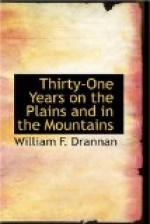The stretching is done by making a bow of a small willow or other pliant wood, for each hide, and then pulling the hide over it. The hides are thus left until they are dry, when the bows are taken out and the hides are packed in a frame made for that purpose, fifty in a bale.
All of this kind of work I had learned at Bent’s Fort, while there, from the many trappers there. Besides, Uncle Kit had given me other lessons in the work.
Uncle Kit and Mr. Hughes made a trip to the cache every other day until the stuff was all packed up to our winter quarters.
I had my hands full attending to the traps, as the men brought more of them on the second trip, and they set enough of them to make double work for me. One dozen traps is called a “string,” and it is considered one man’s work, ordinarily, to “tend a string.”
The two men brought all the stuff up from the cache in five trips. On the day the last trip was made, I went out early, as usual, to attend to the traps, of which we had thirty-six. That morning I took twenty-three beaver, and seeing that it would be impossible for me to skin them all, I set about to carry them to the dug-out. If ever a boy worked, I did that day, and had just got through carrying them in when Uncle Kit and Mr. Hughes returned.
After we had got caught up with our work and rested a few days, Uncle Kit said one morning that we must be out early next day and get our work done so that we could go and kill some elk. “For,” said he, “we have got to have meat for the winter and we must have some hides for beds.”
In those days the trappers made their beds by first constructing a frame or rough bedstand, over which they stretched a green elk hide, securing that by thongs or strings cut from a green deer skin. By lying on these at once, before they are dry, they get shaped to the body and they make a first-class bed for comfort.
We were out early to the traps next morning, and the catch being somewhat smaller than usual, we got through by 11 o’clock, and after eating a “snack”—a lunch—we started on the elk hunt.
After going about four miles we jumped up a band of fifty elk, which was considered a small herd then. But we didn’t get close enough to shoot any of them.
“Let ’em go,” said Uncle Kit; “no doubt they will go to the quaking-asp grove, and we can git ’em to-morrow.” So we returned to camp without any elk. But the next morning we went to the quaking-asp thicket, and there, sure enough, we found the same band of elk, and succeeded in killing five of them. Thus we had enough meat to last a year, if we had wanted that much, and we had skins enough for our beds and moccasins for the winter.
Now we were in no danger of starving, and from now on we could devote our whole attention to the traps.
I had to work very hard that winter, but I was much better contented than when I was with Drake and in the grasp of that old “nigger wench.”




